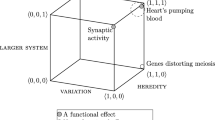Abstract
The survival enhancing propensity (SEP) account has a crucial role to play in the analysis of proper function. However, a central feature of the account, its specification of the proper environment to which functions are relativized, is seriously underdeveloped. In this paper, I argue that existent accounts of proper environment fail because they either allow too many or too few characters to count as proper functions. While SEP accounts retain their promise, they are unworkable because of their inability to specify this important feature. However, I suggest that this problem can be overcome by the application of a new strategy for specifying proper environment that is grounded in the operation of natural selection and I conclude by offering a first approximation of such an account.
Similar content being viewed by others
References
Bardon A. (2007) Reliabilism, proper function, and serendipitous malfunction. Philosophical Investigations 30: 45–64
Bigelow J., Pargetter R. (1987) Function. The Journal of Philosophy 84: 181–196
Cartwright N. (1986) Two kinds of teleological explanation. In: Donagan A., Perovich A. N., Wedin M. V. (eds) Human nature and natural knowledge. D. Reidel, Dordrecht, pp 201–210
Cummins R. (1975) Functional analysis. The Journal of Philosophy 72: 741–765
Cummins R. (1983) The nature of psychological explanation. MIT Press, Cambridge, MA
Dice L. R., Blossom P. M. (1937) Studies of mammalian ecology in Southwestern North America with special attention to the colors of desert mammals. Publication Carnegie Institution of Washington 485: 1–25
Griffiths P. E. (1993) Functional analysis and proper function. The British Journal for Philosophy of Science 44: 409–422
Hoekstra H. E. (2006) Genetics, development and evolution of adaptive pigmentation in vertebrates. Heredity 97: 222–234
Mayr E., Ashlock P. D. (1991) Principles of systematic zoology. McGraw-Hill, New York
Millikan R. (1984) Language, thought, and other biological categories: New foundations for realism. MIT Press, Cambridge, MA
Miquelle, D. G., & Nath, L. (2007). Tiger. In D. W. Macdonald (Ed.), The encyclopedia of mammals. Oxford: Oxford University Press. Retrieved September 27, 2008, from Oxford Reference Online.
Mitchell S. D. (1995) Function, fitness, and disposition. Biology and Philosophy 10: 39–54
Mossio M. et al (2009) An organizational account of biological functions. British Journal of Philosophy of Science 60: 813–841
Neander K. (1991) Functions as selected effects: The conceptual analyst’s defense. Philosophy of Science 58: 168–184
Plantinga A. (1993) Warrant and proper function. Oxford University Press, Oxford
Reed D. H., Bryant E. H. (2000) Experimental tests of minimum viable population size. Animal Conservation 3: 7–14
Walsh D. M. (1996) Fitness and function. The British Journal for the Philosophy of Science 47: 553–574
Wright L. (1973) Functions. Philosophical Review 82: 139–168
Wright L. (1976) Teleological explanations: An etiological analysis of goals and functions. University of California Press, Berkeley
Author information
Authors and Affiliations
Corresponding author
Rights and permissions
About this article
Cite this article
Bertrand, M. Proper environment and the SEP account of biological function. Synthese 190, 1503–1517 (2013). https://doi.org/10.1007/s11229-011-9889-5
Received:
Accepted:
Published:
Issue Date:
DOI: https://doi.org/10.1007/s11229-011-9889-5




